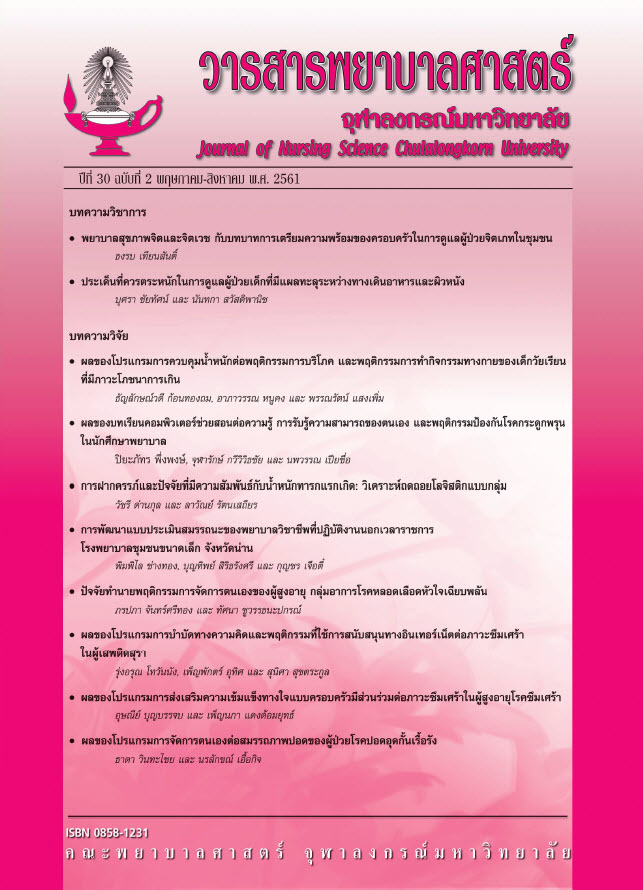Issues to be concerned for Caring Children with Enterocutaneous Fistula
Main Article Content
Abstract
Enterocutaneous fistula is a severe complication for post abdominal surgery affecting both physical and mental of children and their families. Which can interrupt children’s growth, development and learning. It is challenged for health care professionals to provide care for continued incision wound recovery process, observe for possible complication post surgery, and provide mental support to patients and families in order to promote their quality of life. This article present a case study of enterocutaneous fistula patients including types, causes, diagnosis and treatment as well as related issues that should be concerned by health care professionals who taking care of enterocutaneous fistula patients.
Article Details

This work is licensed under a Creative Commons Attribution-NonCommercial-NoDerivatives 4.0 International License.
ลิขสิทธิ์ของบทความที่ตีพิมพ์เป็นของวารสารพยาบาลศาสตร์ จุฬาลงกรณ์มหาวิทยาลัย ทั้งฉบับตีพิมพ์เป็นรูปเล่มและเอกสารออนไลน์
References
Chobsin, P. (2013). Crohn’s Disease: a case report. Journal of Prapokklao Hospital Clinical Medical Education Center, 30(3), 222-229.
Gurtner, G.C., Wong, V.W. (2014). Wound healing: normal and abnormal. Grabb and Smith’s Plastic surgery. 7th ed. (pp. 13-28). Philadelphia: Lippincott Williams & Wilkins.
Jenwiteesuk, K. (2013). Negative Pressure Wound Therapy (NPWT). Srinagarind Medical Journal, 28 suppl, 32-35.
Jivapaisarnpong, P. (2012). Appliances and Accessories. In Jivapaisarnpong. P (Ed.), Colostomy/Ileostomy (pp.145-158). Bangkok: Bangkok Wetchasan.
Kate, V., & Geibel, J. (2016). Enterocutaneous fistula. Retrieved from https://emedicine.medscape.com/article/1372132-overview
Kerdsinchai, T., & Laohawiriyakamol, S. (2015). Collective review Management of enterocutaneous fistula. Retrieved from https://medinfo2.psu.ac.th/surgery/ Collective%
20review/2558/19.Management_of_enterocutaneous_fistula%20 (Trithip%2023.9..58).pdf.
Kumar, P., Maroju, N.K., & Kate, V. (2011). Enterocutaneous fistulae: etiology, treatment, and outcome-a study from South India. The Saudi Journal of Gastroenterology, 17(6), 391-
395.
Kumar, P., Namrata, Ahmad, S. (2015). Enterocutaneous fistula: different surgical intervention technique for closure along with comparative evaluation of aluminum paint, kalaya gum
(Hollister) and gum acacia for peristomal skin care. Journal of Clinical and Diagnostic Research, 9(12),16-20.
Lee, S.H. (2012). Surgical Management of Enterocutaneous Fistula. Korean Journal of Radiology, 13 Suppl 1, 17-20.
Nix, D., Bryant, A.R. (2016). Fistula Management. In Doughty B.D., McNichol L.L., (Eds.), Wound Management. (pp.704-720). China.
Tong, C.Y., Lim, L.L., & Brody, R.A. (2012). High output enterocutaneous fistula: a literature review and a case study. Asia Pacific Journal of Clinical Nutrition, 21(3), 464-469.
Uba, A.F., Uba, C.S., & Ojo, O.E. (2012). Management of post operative enterocutaneous fistulae in children: A decade experience in a single centre. African Journal of Paediatric
Surgery, 9(1), 40-46.
Vinaikosol, G. (2556). Advanced Wound Dressing. Srinagarind Medical Journal, 28 suppl,18-23.
Wutidilokprapan, U. (2558). Nursing Care for Enterocutaneous fistula. In Prasungsit, C. & Rungsangjun, K (Eds.), Enterostomal Nursing Care: Experience from Experts (pp. 137-151).
Bangkok: PA living.
Yamada, S. (2007). Prevention and management of Enterocutaneous fistula. Retrieved from https://www.med.cmu.ac.th/dept/ surgery/gastro/education detail.php?edu_id=2

